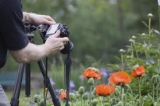- Forum
- General Discussion | Introductions | Off Topic Forum
- Photography General Discussion
- Photographing a person outdoors who wears glasses - how to cut glare?
Photographing a person outdoors who wears glasses - how to cut glare?
-

- Razky
- Newbie
- Follower: 1
-
Points:
4013
Post #758973
Block the light that's causing the glare. Also employ a polarizing filter.909Randy wrote: I was trying to photograph someone yesterday who was wearing glasses and I kept getting a glare from their glasses. Which means you don't see their eyes so well. What's a work around to this without having them remove their glasses?
-

- CharleyL
- Photography Hooked
-
- Canon 90D, (2) Canon 77D, Fuji HS20 EXR, Still have my Sony MVC-FD95
- Followers: 72
- Posts: 921
-
Points:
35375
Post #758975
The light source you are likely dealing with is the Sun, or a flash mounted on the camera hot shoe, so try the following -
If using flash on the camera hot shoe, the reflection off their glasses can be eliminated simply by having them turn their head just slightly left, right, up, or down so the reflection off the glasses doesn't come straight back at the camera. A couple of shots with them moving very slightly each time is going to find the position that is best.
If using off camera flash, move the flashes just enough to avoid the reflection coming back to the camera. Flashes with modeling lights are helpful here. Having them move their head slightly as above can also be of help
A circular polarizing filter would definitely help if nothing else is sufficient.
You could also move the camera a little right or left if the specific background is important. One of these suggestions, or a combination of them, usually works well.
Of course, you can't move the Sun, but you can wait while it moves and then take the desired shots when it's right, or you can use one or more of the flash suggestions of moving the subject slightly to change the angle of reflection off their glasses enough that it doesn't come back to the camera.
I, as well as my subjects/models, prefer working in the shade on bright Sunny days, so we find a large tree or building that offers some shade from the direct Sun and set up the shoot there, but I'm in Eastern USA where cloudless bright Sunny days are quite rare. Most are partly cloudy and sometimes a passing cloud causes shooting delays.
If I need more light in different positions, one or more large 5 way reflectors can be held by assistants or stands to reflect the Sunlight toward the subject/model and provide the needed additional light, but they will need frequent adjustments as the Sun moves, so probably every 15 - 30 minutes. Reflecting the light from a flash or the Sun makes it softer. Celebrate the shadows to enhance the image's apparent depth. Evenly bright lit and shadow free images are flat and uninteresting. TV Newsrooms are an example. Study the shadows and shading of good portraits and learn how to create it.
On bright, but cloudy days I may resort to using flash, but I still use the reflectors to minimize how many flashes that are needed. I have never needed to "Over Power The Sun". I make use of it when it's available to minimize how much lighting and gear that I need to use. I have never taken flash equipment with more than 400 w/s with me for outdoor shoots. I use what's already there to my advantage.
Learn what lighting each piece of gear that you have produces, how soft/hard the light that it produces and the area that it covers at usual working distances, then where to position it for the best effect. Use the shadows to add interest and dimension to your shots as you fully light the "important to see" portions of the shots. We are accustomed to seeing people that are brightly lit from one direction. If the opposite direction is too dark, add enough light to thin and reduce the shadows with additional light, but don't try to eliminate it or the photo will become flat and uninteresting.
Way more information than you had asked for, but I think it will help.
Charley
-

- ThatNikonGuy
- Master of the Lens
-
- Nikon D810 & D300
- Followers: 299
- Posts: 1888
-
Points:
16120
Post #759095
-

- EOS_Fan
- Photography Hooked
-
- Canon EOS 60D
- Followers: 162
- Posts: 642
-
Points:
6154
-

- CharleyL
- Photography Hooked
-
- Canon 90D, (2) Canon 77D, Fuji HS20 EXR, Still have my Sony MVC-FD95
- Followers: 72
- Posts: 921
-
Points:
35375
Post #759229
Using more carefully placed lighting and camera positions is the more professional photographer way. Maybe you need a little practice for this. It's usually easy to find someone to help you, a friend or relative maybe, to pose for you for you while wearing glasses, their's, or even a pair of Sunglasses that you supply.
Try slightly different lighting and head positions. Keep the lights higher than their heads and use live view on your camera to find positions that don't reflect the lights off their glasses and toward the camera. Move the lights if their positions cause problems with their preferred head positions and your camera positions.
You can't do this with flashes, but a constant light source in that same light position will work for this. Then you can replace it with a speedlite or other flash once the position is found that no longer reflects off the glasses and toward the camera.
In most cases, all you need to do for flash is to take a test shot, and if there are catchlights on the glasses that you can see in the test shot, just have them move their head a little bit or you the light source a little bit, so the reflection off their glasses does not go toward the camera, then try another test shot. In just a couple of test shots you will have the photo without the reflection off the glasses.
When I am about to do portrait shoots with or without eye glasses involved, I always talk to the subject and tell them that when I ask for them to move, I only want a few degrees of movement, not a 45 degree kind of change. If it isn't enough, I tell them that I will repeat the request so they can move just a little more. Hand motion with my non camera hand held up vertical, then moved slightly left right, up, or down as I say the desired direction is usually very helpful to them. It's almost like you are reaching out and moving their head for them. Also keep in mind that your verbal left, right, up, and down commands should be their left, right, up, and down, and not yours, and many people don't know their left and right, so your hand motion is what they will follow best.
Time spent talking directly to them in a few minute friendly conversation before the shoot lets you also find out more about them and relaxes them with this friendly one on one conversation. You learn a little more about them and you can make decisions about their good face side, etc. while they become more comfortable about this stranger who is about to take photos of them. They have more trust in you and they aren't as rigid in their poses, which makes for much more natural shots. You can't rush a photo shoot. Stay calm and chat with the subject as you work. Even when something goes wrong, just continue working and over come the problem while you continue smiling and taking frequent test shots. They erase later quite easily. They are only free electrons until you push the shutter button and then they are just organized free electrons. It's very easy to
hit the erase button and send them all back to the free electron storage place in the camera or PC. Printing the organized electron (photo) files is the expensive part.
Charley
- Forum
- General Discussion | Introductions | Off Topic Forum
- Photography General Discussion
- Photographing a person outdoors who wears glasses - how to cut glare?
Latest Reviews
The Panasonic G9 II is a 25.2-megapixel micro four thirds camera with numerous features that make it punch out of its weight class, like 779 AF points, 5.8K video, and weather sealing.
The Fujifilm XT5 is a 40MP mirrorless camera capable of 6.2K video at 30p. With those specs, it’s an ideal choice for photographers needing a camera to pull double duty for imaging and video.
The Canon EOS R100 is an entry-level mirrorless camera introduced in 2023. But just because it’s an entry-level camera doesn’t mean it’s a bare-bones camera. Find out why in this review!
Nikon’s retro-looking Nikon Zfc is anything but retro. Under its classic body is a host of features and amenities that make it a worthwhile compact mirrorless camera for 2024.
Forum Top Posters
-
1Scotty 6 posts
-
2TCav 6 posts
-
3Ruby Grace 4 posts
-
4Street Shark 4 posts
-
5Nefarious 3 posts
-
6Roger Lang 3 posts
-
7Carter Gledhill 2 posts
-
8Chris Briggs 2 posts
-
9Garbo 2 posts
-
10amirahusse... 2 posts
Latest Articles
Starting a photography business is one thing; sustaining your business over a long period of time is another. Use the tips in this professional photography guide to build something with longevity!
The Panasonic G9 II is a 25.2-megapixel micro four thirds camera with numerous features that make it punch out of its weight class, like 779 AF points, 5.8K video, and weather sealing.
Cinematic photography is an interesting genre that combines photographic and videographic skills along with effective storytelling techniques. The result? Highly impactful images!
Newborn photography requires skill, the right gear, and a lot of patience. This beginner’s guide discusses critical topics that will help you be more prepared for before, during, and after the shoot.
To fill the frame means to expand the footprint of the subject in your shot. Get in close, zoom in, crop the image, or use other techniques to bring the subject to the forefront.
With these simple yet effective beginner photography tips, you can avoid some of the common mistakes beginners make and get improved results with your images.
Urban photography is a genre showcasing features in urban settings. You can photograph people, architecture, mass transit, and many other subjects. Learn how to do so in this guide!
The Nikon D850 might be an older DSLR, but it was ahead of its time when it debuted in 2017. That means it still has plenty of firepower to compete with today’s powerful mirrorless cameras.














